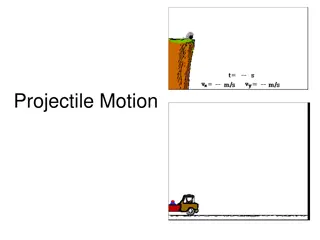Understanding Projectile Motion: An In-depth Analysis
Explore the principles of projectile motion through images illustrating the effects of gravity on launched objects. Learn about the vertical and horizontal components, velocity changes, range, and how different launch angles impact the trajectory and distance traveled by projectiles.
Download Presentation

Please find below an Image/Link to download the presentation.
The content on the website is provided AS IS for your information and personal use only. It may not be sold, licensed, or shared on other websites without obtaining consent from the author. Download presentation by click this link. If you encounter any issues during the download, it is possible that the publisher has removed the file from their server.
E N D
Presentation Transcript
5.6 Projectiles Launched at an Angle
5.6 Projectiles Launched at an Angle No matter the angle at which a projectile is launched, the vertical distance of fall beneath the idealized straight-line path (dashed straight lines) is the same for equal times.
With no gravity the projectile would follow the straight-line path (dashed line). But because of gravity it falls beneath this line the same vertical distance it would fall if it were released from rest.
If there were no gravity the cannonball would follow the straight-line path shown by the dashed line. The vertical distance it falls beneath any point on the dashed line is the same vertical distance it would fall if it were dropped from rest:
Height The cannonball s motion is made up of two component vectors: the horizontal component is always the same the vertical component changes the same way it would for an object thrown up into the air or dropped
The velocity of a projectile is shown at various points along its path. Notice that the vertical component changes while the horizontal component does not. Air resistance is neglected.
Range The angle at which the projectile is launched affects the distance that it travels. Range - the horizontal distance a projectile travels
Compare: Both pictures show an object launched at the same SPEED but different ANGLES.
Horizontal Ranges Projectiles that are launched at the same speed but at different angles reach different heights (altitude) above the ground. They also travel different horizontal distances, that is, they have different horizontal ranges.
The paths of projectiles launched at the same speed but at different angles. The paths neglect air resistance.
The same range is obtained for two different projection angles angles that add up to 90 . An object thrown into the air at an angle of 60 will have the same range as at 30 with the same speed. Maximum range is usually attained at an angle of 45 .
Maximum range is attained when the ball is batted at an angle of nearly 45 .
Speed Without air resistance, a projectile will reach maximum height in the same time it takes to fall from that height to the ground. The deceleration due to gravity going up is the same as the acceleration due to gravity coming down. The projectile hits the ground with the same speed it had when it was projected upward from the ground.
Without air resistance, the speed lost while the cannonball is going up equals the speed gained while it is coming down. The time to go up equals the time to come down.
In the presence of air resistance, the path of a high-speed projectile falls below the idealized parabola and follows the solid curve.
think! A projectile is launched at an angle into the air. Neglecting air resistance, what is its vertical acceleration? Its horizontal acceleration?
Answer: Its vertical acceleration is g because the force of gravity is downward. Its horizontal acceleration is zero because no horizontal force acts on it.
think! At what point in its path does a projectile have minimum speed?
Answer: The minimum speed of a projectile occurs at the top of its path. If it is launched vertically, its speed at the top is zero. If it is projected at an angle, the vertical component of velocity is still zero at the top, leaving only the horizontal component.























